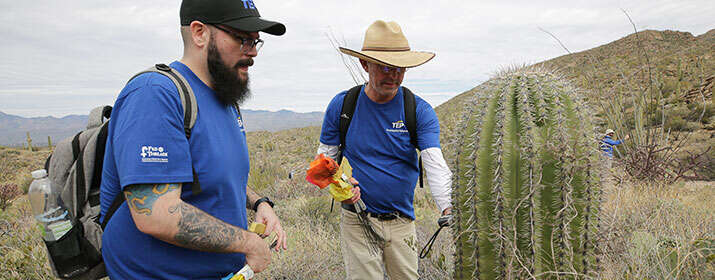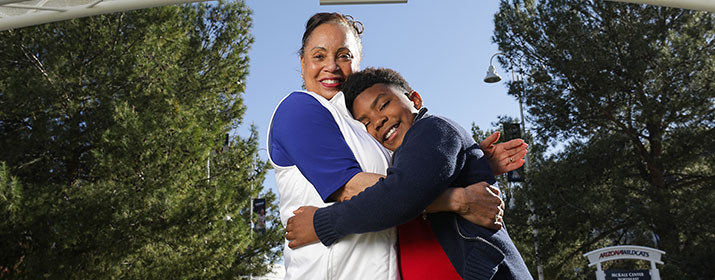
Tucson Electric Power is one of the state’s largest developers, with infrastructure spanning a service area that includes more than 1,100 square miles.
The responsibility for making sure our projects are developed sensitively, safely and within strict land use requirements falls to TEP’s Land Resources team.
We sat down with Environmental & Land Use Planning Supervisor Brian Pugh and Right-of-Way Supervisor Renee Marruffo to have them explain what they do and share their guiding principles.
What does TEP’s Land Resources do?
Pugh: Our 20-member team is responsible for ensuring that we secure the necessary authorization and legal land rights for any of TEP’s equipment or facilities that will be located on public, private or tribal property. This includes transmission lines, overhead distribution lines, underground cables, substations and other equipment that we construct, access, operate and maintain.
We’re a diverse group with varied experience, including right-of-way agents, environmental & land use planners, and geographic information system (GIS) analysts who provide multi-disciplinary development services.
What are our guiding principles for managing the land where our facilities are located?
Pugh: Our approach is to leave as light of a footprint as possible on the environment. Our partnership with the Tucson Cactus & Succulent Society (TCSS) is a good example of that.
The Society works with us to rescue cacti and plants in our project areas. Their volunteers salvage the plants from our construction sites and then sell them to the public and businesses to help recover their costs for permits and tags from the Arizona Department of Agriculture. The proceeds also help fund their educational efforts on conservation.
We’ve collaborated with the Society on many projects since 2008. Over the last three years, they helped salvage cacti from the sites of our Raptor Ridge solar array project and our new Harrison and Sonoran Substations.
Sustainability is one of our corporate values because doing the right thing is just good business. A small footprint respects landowner interests, protects sensitive resources and contains costs, all of which help maintain reliability and contribute to lower rates.
One good example of our small footprint philosophy is the Pinal Central-Tortolita 500kV Transmission Line project that TEP installed along 41 miles in northern Pima and southern Pinal Counties in 2014. The proactive, collaborative approach from project design through construction protected more than 80 percent of the right-of-way, including sensitive cultural resources and more than 1,200 saguaros.
What other environmental groups does TEP work with when we have construction projects?
Pugh: We work with many environmental advocacy organizations to protect and preserve wildlife and the natural environment, including Friends of Saguaro National Park, Sky Island Alliance and Tucson Clean & Beautiful. We also work with tribal nations, and local, state and federal agencies to help ensure we have the regulatory approvals to conduct our business.
How does the company secure a pathway and access for our facilities?
Marruffo: TEP is regulated by Arizona law and the Arizona Corporation Commission. If we initiate a project, we take a typical real estate approach to secure the land rights and approvals by determining market value, negotiating the terms and finalizing the agreement, including all land use regulations and requirements before we install our facilities. When customers requesting service initiate projects, they are responsible for providing all the required land rights, terms, payments and civil work.
Pugh: It is worth noting that we carry out extensive public outreach programs for all of our major construction projects to seek input from the public and stakeholders. We always try to be transparent so that customers have a clear understanding of our projects. We hold meetings to engage with residents and businesses located near the project site to take their questions, provide answers and get input. We also share information with the community about our plans, consider their suggestions and post most of our major projects on our website as soon as they begin.
What is the biggest opportunity for Land Resources?
Marruffo: As we’re modernizing our transmission and distribution system, the Land Resources team helps ensure reliable service for all of us while making sure we are keeping costs as low as possible for our customers. Balancing modernization with protecting the natural environment helps steward this area where we all live, enjoy and want to preserve. By collaborating with landowners and regulators with transparency, fairness and a cooperative spirit, we successfully manage and build projects and relationships.






